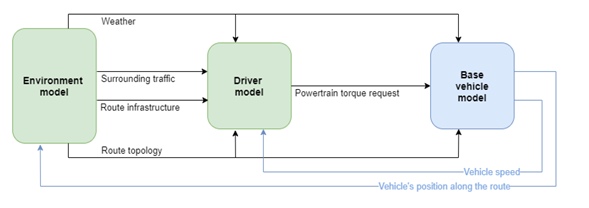
CEVOLVER aims at both minimizing the energy consumption and providing more confidence to the user of an electric vehicle. The latter is achieved by preventing low battery situations via optimal trip planning that includes the schedule of charging processes as well as the energy-optimal trip. To this achieve this purpose, CEVOLVER project has developed a connected virtual simulation framework that allows the development of advanced energy and thermal management strategies (i.e. eco-routing, eco-driving, assured charging, predictive thermal management, and smart fast charging).
This framework includes a base electric vehicle model, as well as models of the driver and of the vehicle’s surrounding environment to represent situations as close as possible to reality. It is also used to test the defined use-cases for CEVOLVER. The set-up, parametrization, calibration, validation of the base vehicle model with models from different sources and model developers, and their integration into a representative simulation platform and usable tool presented a great challenge. To reduce the risk of being confronted with major issues at the integration stage, a systematic, iterative approach was followed. The approach is based on the use of standard model interfaces, which are defined based on the standardized interfaces developed in the H2020 HIFI-ELEMENTS project. The interfaces are completed with additional interfaces in cases where the HIFI-ELEMENTS standards were insufficient. The use of standard interfaces for the models allows for the start of the process of model integration, by means of use-ready models in an operational vehicle simulation to resolve potential compatibility issues early in the process. By using the standard interfaces, model complexity can be introduced in a later stage if deemed useful, by interchanging the existing models.
The base vehicle model is extended with an environment model and a driver model which is sensitive to external factors, namely, the route topology and infrastructure, the surrounding traffic, and the weather conditions. This is connected to a brand-independent cloud, providing real-time and predictive data about the aforementioned factors from third party providers.
The simulation framework has been used in a first phase to aid project partners in the sizing of components for their demonstrators by supporting the engineering decisions. The framework is later used to develop the advanced energy and thermal management strategies in a virtual environment prior to being implemented and tested in the demonstrator vehicles.
